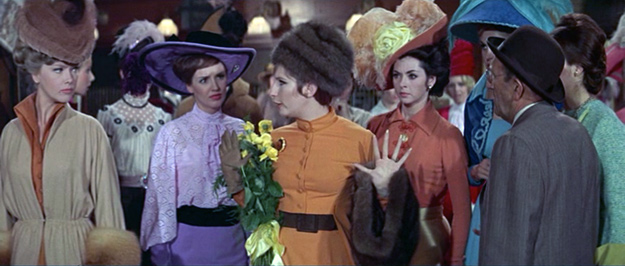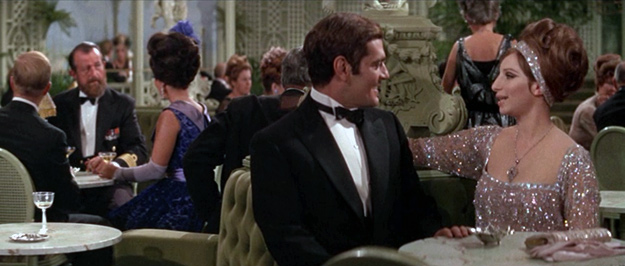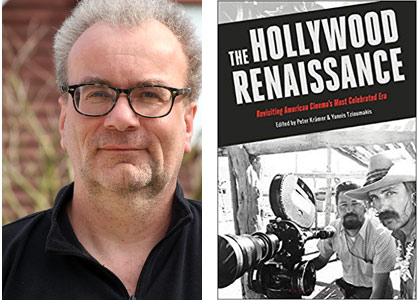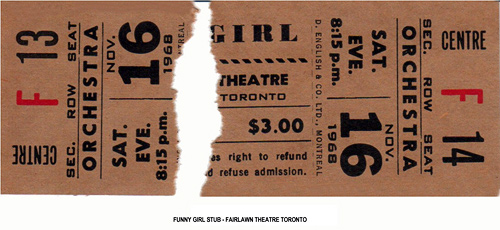“Funny Girl’s legacy and value is as a recreation of Streisand’s one-for-the-ages turn in the stage version, now preserved as long as we can watch movies.” — Matthew Kennedy, author of Roadshow! The Fall of Film Musicals in the 1960s
The Digital Bits and History, Legacy & Showmanship are pleased to present this retrospective commemorating the golden anniversary of the release of Funny Girl, the motion picture adaptation of the stage musical featuring Barbra Streisand’s Academy Award-winning performance as comedienne Fanny Brice.
Produced by Ray Stark (Annie, The Way We Were) and directed by William Wyler (The Best Years of Our Lives, Ben-Hur), the award-winning film also starred Omar Sharif (Lawrence of Arabia, Doctor Zhivago) and Kay Medford (BUtterfield 8, Ensign Pulver). The Library of Congress in 2016 selected Funny Girl for preservation in the National Film Registry. [Read on here...]
The popular musical recently turned fifty, and for the occasion The Bits features a Q&A with a trio of film historians who reflect on the film’s appeal and legacy.

FUNNY GIRL NUMBER$
- 1 = Number of Academy Awards
- 1 = Rank among Columbia’s all-time top-earning movies at close of original release
- 1 = Rank among top-earning films with Streisand in a lead role (adjusted for inflation)
- 2 = Number of markets showing the movie during opening weekend
- 2 = Rank among top-earning films of 1968 (retroactive / legacy / lifetime earnings)
- 2 = Rank among top-earning films of 1969 (calendar year)
- 5 = Number of years Columbia’s top-earning film
- 5 = Rank among top-earning 1960s musicals
- 8 = Number of Academy Award nominations
- 11 = Rank among top-earning movies of the 1960s (earnings from 1/1/60 - 12/31/70)
- 15 = Peak all-time box-office chart position
- 16 = Rank on AFI’s list of Greatest Movie Musicals
- 72 = Number of weeks of longest-running engagement
- $14.1 million = Production cost
- $16.5 million = Box-office rental through 12/31/69 (% of gross paid to distributor)
- $24.6 million = Box-office rental through 12/31/70
- $24.9 million = Box-office rental through 12/31/71
- $25.6 million = Box-office rental through 12/31/72
- $26.3 million = Box-office rental through 12/31/73
- $52.2 million = Box-office gross
- $101.7 million = Production cost (adjusted for inflation)
- $175.7 million = Box-office rental (adjusted for inflation)
- $357.2 million = Box-office gross (adjusted for inflation)
THE Q&A
Kim R. Holston is the author of Movie Roadshows: A History and Filmography of Reserved-Seat Limited Showings, 1911-1973 (McFarland, 2013). Kim is a part-time librarian in the Multimedia Department of Chester County Library (Exton, PA) and lives in Wilmington, Delaware, with his wife Nancy and a menagerie of pets. He is the author or co-author of several other film and performing arts books, including Science Fiction, Fantasy and Horror Film Sequels, Series and Remakes: An Illustrated Filmography, Volume II (1996-2016) (with Tom Winchester, McFarland, 2018), Naval Gazing: How Revealed Bellybuttons of the 1960s Signaled the End of Movie Cliches Involving Negligees, Men’s Hats and Freshwater Swim Scenes (BearManor Media, 2014), Attila’s Sorceress (New Libri Press, 2014), The Shakespeare Controversy (with Warren Hope; McFarland, 2nd ed., 2009), Susan Hayward: Her Films and Life (McFarland, 2002), Science Fiction, Fantasy and Horror Film Sequels, Series and Remakes: An Illustrated Filmography (with Tom Winchester, McFarland, 1997), Richard Widmark: A Bio-Bibliography (Greenwood Press, 1990), and Starlet (McFarland, 1988).
Matthew Kennedy is the author of Roadshow! The Fall of Film Musicals in the 1960s (Oxford University Press, 2014). Matthew is a writer, film historian, and anthropologist living in Oakland. His other books include Joan Blondell: A Life between Takes (University Press of Mississippi, 2007), Edmund Goulding’s Dark Victory: Hollywood’s Genius Bad Boy (University of Wisconsin Press, 2004), and Marie Dressler: A Biography (McFarland, 1999). His articles have appeared in the program books of the San Francisco Silent Film Festival and Turner Classic Movies Classic Film Festival. He is film and book critic for the respected Bright Lights Film Journal and has hosted retrospectives based on his books at the Pacific Film Archive, UCLA Film Archive, and the Museum of Modern Art.
Peter Krämer is the editor (with Yannis Tzioumakis) of The Hollywood Renaissance: Revisiting American Cinema’s Most Celebrated Era (Bloomsbury Academic, 2018). Peter is the author and/or editor of several additional academic books, including a BFI Film Classics volume on 2001: A Space Odyssey (2010), The New Hollywood: From Bonnie and Clyde to Star Wars (Wallflower, 2006), and American Graffiti: George Lucas, the New Hollywood and the Baby Boom Generation (forthcoming from Routledge). He is a Senior Fellow in the School of Art, Media and American Studies at the University of East Anglia in Norwich (UK).
The interviews were conducted separately and have been edited into a “roundtable” conversation format.
Michael Coate (The Digital Bits): How do you think Funny Girl should be remembered on its golden anniversary?
Kim R. Holston: As the film that made Barbra Streisand a star.
Matthew Kennedy: Funny Girl was, is, and forever should be remembered as Barbra Streisand’s film debut. By the time this film appeared in 1968, she had conquered Broadway in the stage version of Funny Girl, was an established recording star, and had performed in top-rated TV specials. Movie stardom might have seemed inevitable, but would her unconventional looks translate on the big screen? The results dazzled and exceeded already high expectations. The film has merits beyond her performance, but they take a backseat to her.
Peter Krämer: As arguably the most amazing movie debut by any performer ever: Barbra Streisand combines rapid fire comic delivery, slapstick comedy, numerous costume changes, melodramatic acting and that amazing singing voice into something quite incomparable.
As an incredibly moving biopic in which the lead actress does not only bring a legendary Jewish performer (Fanny Brice) back to life, but also tells her own story about becoming “the greatest star” against all the odds. Indeed, by the time she appeared in the movie version of her Broadway hit Funny Girl, Streisand’s amazing success as a theatre and concert performer, as a recording artist and television personality had already made her, at the young age of 26, the biggest star in American entertainment, not only of the 1960s but quite possibly of all time.
As the beginning of an unprecedented film career, which saw Streisand appear in an almost unbroken string of hits until 1979 (while her success in other media continued as well). Her track record at the box office during this period far exceeded that of all other female movie stars then or later, and was the equal of any male star at a time when women were more marginalized in Hollywood than ever before or since.
Coate: What do you remember about the first time you saw Funny Girl?
Holston: The first time I saw it I did not care for it. It seemed archaic. Remember, it was 1968 and the world had changed dramatically (Vietnam War, civil rights marches, political assassinations). Funny Girl looks better in retrospect, perhaps because it represents one of the last good roadshow musicals. Watching the DVD version, which features an Overture, Entr’acte and Exit Music, I waxed nostalgic. Something jarring I noticed while watching this and the same year’s other giant musical, Star!, with Julie Andrews and was perhaps why I didn’t like it in 1968 were the close-ups during the stage production numbers. It was unrealistic. No audience member without opera glasses could home in on the performers like this. Upon reflection, I realized that this sort of camerawork did occur in such classic Hollywood “stage” musicals as 42nd Street and Alexander’s Ragtime Band. Perhaps it was the era of the 60s. “Realism” was in.
Kennedy: I saw Funny Girl at the Showcase, the one fancy first run theater in my hometown of Redding, California. I remember being excited during the opening credits, a kind of big city big show excitement not often available in Redding. And then there she was — this giantess demanding not only our attention, but also our awe and supplication.
I remember media obsession over her looks, specifically her large nose. Will she or won’t she have it reduced? It’s easy to forget what an exceptionally special and odd creature she was on first sight. She wholly embraced her singular place in show business. It worked brilliantly for her. It was as though society was congratulating itself on prizing a woman of such rare talent who redefined beauty.
Krämer: I was doing some research in various archives in Los Angeles, and so as to reward myself for a hard day’s work I thought I might go and see an old musical on the big screen. When I arrived at the cinema I was surprised that the audience consisted almost exclusively of men — and many of them were holding hands or showing each other affection in other ways. Now, I had vaguely been aware of the fact that Streisand was a gay icon, but I had not previously attached any particular meaning to this. But then we all sat down, and when the story finally started (after a long credit sequence — I can’t remember now whether they also played the overture), we followed Streisand, who had her back to the camera, walking through the stage door of the theatre and along various corridors until she came to a tall mirror. Now she finally turned so that her face — with that grand nose of hers — could be seen in the mirror, and she addressed that image: “Hello, Gorgeous.” At this point the auditorium erupted into applause and cheering. And I suddenly understood a little bit about what made her a gay icon. She was different (as the rest of the film makes clear, she — like Fanny Brice — was considered ugly by the standards of beauty of the time, she was too Jewish) — and yet she was able to accept herself just the way she was. Or so it seemed.
Coate: In what way is Funny Girl a significant motion picture?
Holston: It was a star-making turn for Barbra Streisand, who joined a select team of actresses who were stars from their first time on screen, e.g., Katharine Hepburn, Doris Day.
Kennedy: Funny Girl was directed by William Wyler, arguably the greatest director of the studio era. It came along after his heyday, and the commonly heard story is Streisand dominated the set, despite Wyler’s veteran experience. But I wonder — is that representative of sexism, or did she exert influence beyond her domain as a vastly talented, disciplined, and ambitious screen newcomer?
The score is excellent. Broadway Songwriter Jule Styne had a fabled career as composer of Gentlemen Prefer Blondes, Bells are Ringing, and the oft-revived much loved Gypsy, all before Funny Girl premiered in 1964. Here we get Second Hand Rose, My Man, and the hit single People, along with several other worthy tunes.
The film not only preserves and glorifies Streisand’s original stage performance, but also Kay Medford’s playing Brice’s mother.
Funny Girl is also a strong example of how to translate a stage production into cinema. Don’t Rain on My Parade gets opened up to take in lower Manhattan, a train, a boat, and Streisand’s thundering proclamation of a self-guided destiny. Wyler employs those wonderful things unique to cinema — the ability to change perspective and distance with each camera set-up. So while the stage audience thrilled to Streisand live, the film audience sees and hears her in close-up, medium, and far shots, with the camera guiding us and contributing greatly to the emotions of the story. Very often Wyler recreates the stage experience as well, with many scenes of Brice rehearsing or before a live audience. But unlike live theater, we get close enough to see tears welling in her eyes.
Krämer: People often forget that, with the exception of the late 1920s and very early 1930s, Hollywood — an industry pretty much founded and largely run by Jewish-Americans — had always been very cautious about coming across very Jewish. So many actors changed their names — and indeed their looks (through cosmetic surgery). p>
Then in 1967 and 1968 everything changed (at least for a while). Streisand (no name change for her — except for dropping that second “a” in her first name), as mentioned earlier the biggest star in American entertainment, makes her debut in a film about a Jewish performer succeeding against all the odds. And the biggest surprise hit in all of Hollywood history, The Graduate, released late in 1967, but dominating the box office all through 1968, has Dustin Hoffman (no name change here either) appearing in the role of a WASP jock. Several commentator at the time noted that this was a bit of a (perhaps subversive) mismatch.
From then onwards, for about a decade, many of the key performers and the most iconic characters in Hollywood movies were ethnic Americans (mostly Jewish-American or Italian-American). Just think about Don Corleone and Al Pacino.
So, together with The Graduate, Funny Girl marks a real turning point in Hollywood history.










